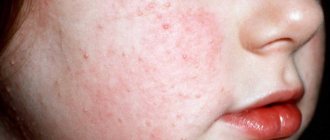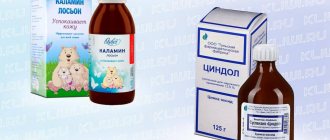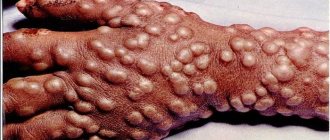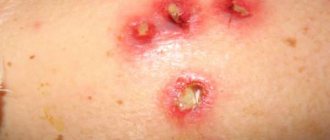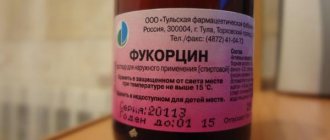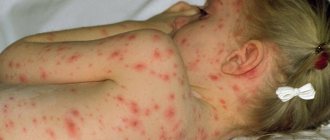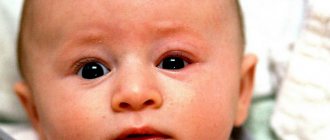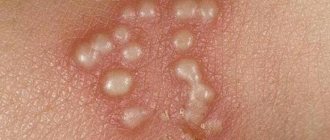Chickenpox in infants - symptoms
The hallmark sign of chickenpox is a red rash that usually starts on the face, neck, or chest and then spreads to other areas of the body. Fluid-filled blisters appear on the body, which crust over within 4-10 days.
Some other signs and symptoms of chickenpox in children include:
- loss of appetite;
- sleep disturbance;
- severe itching;
- fever, which can sometimes begin before the rash appears.
In infants, chickenpox can occur without fever, since their immune system is less developed, and, therefore, the body does not always respond to infection with an increase in temperature. Chickenpox does not usually cause digestive problems such as diarrhea or respiratory symptoms such as nasal congestion or congestion.
Causes
Chickenpox in newborns has several causes:
- the congenital form develops due to intrauterine infection if the pregnant woman was infected at the 20th week of gestation;
- perinatal, in which the infection of the baby’s mother occurred 5 days before birth or within 2 days after it.
If a pregnant woman was infected at the 20th week of gestation, then the congenital form develops due to intrauterine infection.
In infants, chickenpox infection occurs through contact with infected others. The chickenpox virus is a type 3 herpes virus (herpes zoster) and is transmitted by airborne droplets or by direct contact with the contents of the blisters.
The most likely period of infection is the incubation period, when the presence of the virus in the body is still not noticeable, and the height of chickenpox.
Treatment and home remedies
In most infants, the symptoms of chickenpox go away on their own within a week. Treatment is usually aimed at eliminating symptoms.
Home remedies may provide relief.
- Dress your child in loose clothing that does not irritate the skin. To prevent scratching of blisters, wear mittens for your child. Keep your child's nails short to reduce the risk of infection from scratching the blisters.
- Avoid medications containing aspirin. There are concerns that using ibuprofen during chickenpox may cause serious skin infections in some children.
If the symptoms are very severe or the child is at high risk of complications from chickenpox, the doctor may prescribe an antiviral drug. These medications will help the body fight infection and reduce the severity and duration of symptoms. In some cases, your doctor may recommend other treatments to treat complications of chickenpox. For example, a child who is dehydrated due to a high fever and not drinking enough fluids may need intravenous fluids in the hospital.
Features of chickenpox in children under 1 year of age
In a child up to 3 months of age, antibodies received from the mother protect the body from infection. During breastfeeding, the baby receives these antibodies through milk. But if the mother has not had chickenpox or the child’s immunity is reduced due to congenital pathologies, then the risk of infection during this period is especially high.
In a child up to 3 months of age, the body is protected from infection by antibodies received from the mother during breastfeeding.
In children 5-10 months old, the body’s defenses are still weak, but when breastfeeding the baby, the mother’s immunity is “supported”, the antibodies of which the child takes in with milk.
Light form
With strong immunity, chickenpox infection occurs in a mild form, which is accompanied by typical symptoms of the disease. In children aged 1-3 months, rashes can be sporadic; “fresh” areas of rashes appear in waves, accompanied by an increase in temperature. Children easily tolerate this form of chickenpox.
Severe form
The severe form is marked by more pronounced symptoms and occurs with high (up to +40°C) body temperature and a rise in temperature in the area where the rash is localized. In this case, the child experiences a headache, sleep and appetite disturbances, and dyspeptic symptoms accompanied by vomiting.
The severe form is marked by more pronounced symptoms and occurs with high (up to +40°C) body temperature and a rise in temperature in the area where the rash is localized.
The rashes occupy large areas of the skin and mucous membranes. When the mucous membranes of the larynx and oral cavity are “grabbed,” the child experiences suffocation. The rash may appear on the lining of the eyelids and membranes of the eyes, causing:
- redness;
- lacrimation;
- mucus secretion;
- pain and itching.
Intoxication caused by waste products of the virus leads to high fever, which may be accompanied by convulsions in infants.
A severe form of chickenpox is accompanied by the appearance of blisters (bullous form), which heal slowly and, when opened, form large, weeping areas on the body.
Children with a reduced response to physiological and pathogenic stimuli may experience a gangrenous form of chickenpox.
In the generalized form, the rash affects not only the outer surface of the body, but also the internal organs. In children with a reduced reaction to physiological and pathogenic stimuli, a gangrenous form of chickenpox may be observed, in which the blisters, when broken, form long-term non-healing ulcers with signs of necrosis along the edge.
Severe intoxication with these forms of chickenpox can lead to the death of an infant.
The severity of the disease in a child in the first days of life depends on the duration of infection of the mother. If a woman becomes infected immediately before giving birth, the child will develop a severe generalized form of chickenpox. When the mother is infected 5-10 days before birth, chickenpox in the newborn is easier, since the woman has time to develop antibodies to the virus.
Prevention
The Centers for Disease Control and Prevention recommends vaccinating children between 12 and 15 months and 4 and 6 years of age. Vaccinations can virtually eliminate the risk of developing the disease in a child. If a vaccinated child does get chickenpox, which is very rare, the infection will be less severe.
Some other strategies for preventing chickenpox in children include washing hands before eating and after playing, especially if the child has played with other children, and avoiding people infected with chickenpox.
Scientific article on the topic: Infectious diseases suffered in childhood do not affect human life expectancy
.
Chickenpox symptoms
In order for parents to be able to respond in a timely manner if their child is infected with a virus that provokes the development of chickenpox, it is necessary to know how chickenpox begins in infants and what symptoms are characteristic of this disease.
Characteristic symptoms of the development of chickenpox in the body are the following:
- The appearance of red spots on the skin, the diameter of which can reach up to 1 cm. Red spots at the initial stage of disease progression form on the skin of the face and scalp. The spread of such formations occurs quite quickly throughout the child’s body. Subsequently, blisters form in place of the red spots, the cavity of which is filled with a clear liquid.
- The increase in temperature in the case of a mild form of the disease is insignificant, but in a severe form of the disease the temperature can increase to 39-40˚C.
- The number of spots on the skin can increase sharply.
- After 5 days, the resulting blisters burst and a dense crust forms on their surface.
- Increased itching. Its appearance causes the baby to itch and break blisters, thereby promoting the occurrence of secondary infection.
Children under the age of several months are not able to scratch themselves and pick off the resulting blisters, which prevents the risk of secondary infection.
Chickenpox is characterized by a relatively long incubation period for the development of the disease. Which, in turn, can make it difficult to timely detect symptoms of an infectious disease in a child.
From the moment the virus enters the child’s body until the symptoms characteristic of the disease appear, it takes from 7 days to 3 weeks. Most often in practice, the incubation period is up to 21 days.
At the initial stage of development of the disease, the virus adapts to the child’s body; after this stage is completed, mass reproduction occurs. At the same time, at this stage, the baby’s body begins to produce antibodies.
Externally, the second stage of development of the virus in the body is manifested by the baby’s lethargy, increased tearfulness, deterioration of appetite and sleep disturbance. At the third stage of disease progression, the formation of characteristic red spots and an increase in body temperature are observed.
Treatment
Mild chickenpox in infants is treated at home.
- Parents should try to ensure that the baby stays in a cool, clean room during illness (ventilation, wet cleaning).
- Treatment of rash elements with antiseptics and drying agents: brilliant green, Zinc ointment, Fenistil-gel.
- For fever - antipyretics in suppositories or in the form of syrup based on Paracetamol, Ibuprofen.
- For severe anxiety, poor sleep, itching - antihistamines: Fenistil, Suprastin, Tavegil, Diazolin in age-appropriate doses as prescribed by a doctor.
- When elements of a rash appear in the oral cavity, the drug Cholisal is used, which relieves pain and relieves inflammation.
- If you are feeling well and there is no fever, you can bathe your child several times a day in a pink solution of potassium permanganate (potassium permanganate). In this case, it is necessary to follow some rules: water temperature 36-37 oC, swimming should not last more than 10 minutes, it is not recommended to use detergents and sponges. After the procedure, carefully blot the baby’s body with a soft towel and treat all elements of the rash with an antiseptic.
- If the baby is breastfed, frequent breastfeeding is advisable.
- In between feedings, you need to give your baby clean boiled water.
- To prevent scratching of itchy areas, baby onesies are put on undershirts with sewn-up sleeves; at older ages, protective gloves are put on the hands.
- One-year-old babies who are already good with their hands and often pick off chickenpox scabs need to be distracted from this with interesting activities and new toys.
Treatment of severe and complicated forms is carried out in infectious diseases departments of children's hospitals.
- Immediately after diagnosis, treatment of the baby begins with the administration of donor immunoglobulin with antibodies against the chickenpox virus.
- Antiviral drug Acyclovir according to an individually developed regimen.
- Interferon group drugs: Viferon, Reaferon.
- Detoxification measures: parenteral administration of saline solutions, Reopoliglucin, plasma.
- For hemorrhagic form - Contrikal, Vikasol.
- If bacterial purulent complications occur, antibiotics are used; Ceftriaxone, Vancomycin, Ampisid.
Severe form of chickenpox
Very often, chickenpox begins immediately with a severe form. The temperature rises sharply, the child becomes very anxious, his appetite decreases and he refuses to breastfeed. At this time, he may suffer from a headache. And then red spots appear. With this form, it happens that the rash immediately covers the entire body, the temperature rises very much, sometimes even up to 40 degrees. In severe cases, the rash appears several times in waves. After each wave the temperature becomes lower, but with the onset of a new wave it rises again.
Treatment of severe chickenpox
The most dangerous thing during chickenpox is a rash on the mucous membranes. Since it greatly bothers the baby and can cause serious complications. A rash on the larynx can cause suffocation. In this case, you need to immediately call an ambulance and, to alleviate the child’s condition, give a few drops of Fenistil, it will help to slightly reduce the swelling until the doctor arrives. If the child does not have a fever, then lowering the knives into a bowl of warm water will help relieve swelling of the larynx. But if there is even a slight temperature, such procedures cannot be carried out.
If after examination the doctor says that the child is in serious condition, then it is best to agree to hospitalization. In no case should you self-medicate in severe cases of chickenpox, since the risk is directly related to the health of the baby. It is best to contact an experienced doctor who will correctly diagnose and prescribe the necessary treatment, and if necessary, suggest hospitalization, during which the child will be under the constant supervision of doctors.
The appearance of chickenpox in infants is caused by herpes viruses. Such viruses are highly susceptible. If a person has never had chickenpox, then he is strictly prohibited from contacting the sick person, otherwise he himself may become infected. Chickenpox is better tolerated in childhood than in adulthood.
Mild form of chickenpox
Typically, children aged 3-6 months experience chickenpox in a mild form. With such chickenpox, first single blisters appear on the body, and then a rash appears in waves all over the body and the temperature rises. When the rash reaches its peak, the same thing happens with the temperature. As the rash subsides, the temperature also drops.
The rash consists of small, red spots that quickly turn into shiny blisters and are surrounded by a red rim. After about 1-3 days, these blisters dry out and become crusty, but after the rash passes, another wave begins and the body becomes covered with new spots. A rash also very often appears on the mucous membranes, but it goes away quite quickly.
Small infants tolerate chickenpox very poorly due to the fact that the rash is accompanied by severe itching. This does not give the child peace, he cannot sleep well and soundly, and his appetite also disappears. Because of this, the infant refuses to breastfeed, becomes very capricious and tries to scratch the rash.
Treatment of mild chickenpox
Red spots with bubbles filled with liquid must be treated with brilliant green. This needs to be done regularly, as new rashes appear on the body every day. This treatment will allow the bubbles to dry out faster and prevent the entry of various bacteria and the development of rotting. To alleviate the child’s condition and reduce itching, you can lubricate the baby’s body with Fenistil. This gel perfectly relieves itching and helps the child cope with chickenpox more easily. The main thing is not to treat the entire body at once; this must be done gradually and only treat those areas of the skin where the rash is very severe. During chickenpox, you should completely avoid swimming, as water can cause the rash to spread faster throughout the body and increase in number.
To prevent an infant from scratching the rash on his hands, he needs to wear special mittens for babies or clothes that cover his hands.
Complications
Frequent complications are secondary infection of wounds with streptococci and staphylococci. Clinically, this is manifested by the formation of various purulent foci: from superficial impetigo to phlegmon and subcutaneous abscesses.
Complications that are rarely observed in infants with congenital immunodeficiency conditions or in HIV-infected children:
- Chickenpox hepatitis without clinical manifestations, only in blood biochemistry - increased levels of transaminases (ALT, AST).
- Thrombocytopenia, hemorrhagic vesicles, gastrointestinal bleeding.
- Encephalitis.
- Meningoencephalitis.
- Nephrotic syndrome.
- Pneumonia.
- Myocarditis.
- Pericarditis.
- Pancreatitis.
- Orchitis.
Even with a favorable outcome of treatment, the consequences, especially after chickenpox encephalitis, in the form of delayed psychomotor development, paresis, and convulsive seizures, can last for several months in the child.
